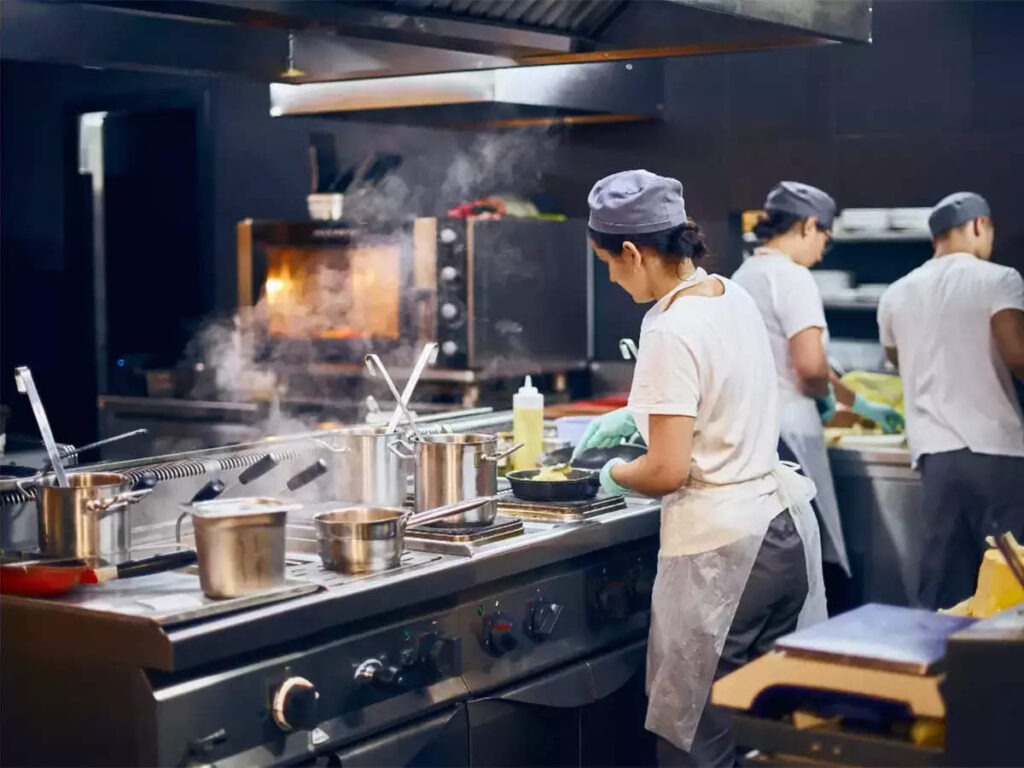
LIST OF EQUIPMENT FOR A CLOUD KITCHEN
1. Exhaust Hood
A commercial kitchen exhaust hood system is a major purchase for all the commercial foodservice facilities. There are typically two types of hoods that you can choose from; Type 1 includes a fire prevention system for kitchen appliances that produce a lot of smoke and grease in cooking chores such as frying, broiling, or grilling. If there is a lot of baking or steaming, which produces only heat and moisture, a Type 2 exhaust hood will typically suffice.
2. Counters
While designing the food preparation area, choose counters that are made from stainless steel. Stainless steel counters are sturdy, resistant to corrosion and bacteria growth. They are easy to maintain and can withstand the harsh cleaning products that are usually used in commercial kitchens.
3. Commercial Reach-In Refrigerators and freezers
Consider purchasing new refrigerators and freezing units that come with warranty coverage and require minimum maintenance. Before buying, conduct proper market research about the different industrial brands/manufacturers that produce refrigeration units for a commercial kitchen.
4. Cooking Range
Before investing in any commercial cooking top/ stove range, analyze whether you want to install a gas-based range or electric range. While gas models make it easier to adjust the heat and temperature settings, electrical products have a smooth, elegant, and easy to clean design.
5. Oven
Even though both standard and convection ovens are considered essential, depending upon your requirement and kitchen space, you can even go for combination ovens. Combi ovens are usually more expensive than a standard or convection oven. However, since they combine the elements of the two units, investing in them may seem a wise decision for your cloud kitchen.
6. Commercial Fryer
For some commercial kitchens, a major deciding factor when selecting a fryer unit is the fryer’s power source. This kitchen equipment typically works on either gas or electricity. Gas fryers are usually cheaper to run and consume less energy over time but can be expensive to install.
Electric fryers, on the other hand, heat up well. They are more mobile and easier to install. Fryers come in different forms and vary according to the size, orientation, style, and other performance metrics. Therefore before making the purchase, compare different models and understand the differences for a smoother analysis.
7. Sinks
Sinks play an essential role in ensuring proper cleanliness in the kitchen and achieving food safety goals. You may install a single, double, or triple-sink wash station along with a dishwashing unit in your commercial kitchen.
8. Fire suppression system
Fire suppression systems come in different sizes and can be installed into the current exhaust hood of the kitchen. Before purchasing any fire, safety, or sanitation equipment, thoroughly check the local fire department guidelines to avoid any potential complications and keep your kitchen up to local fire safety standards.
9. Cutting Surfaces
Even though stainless steel food preparation surfaces are durable, it is recommended not to do the heavy prep work such as slicing, cutting, chopping, etc. – directly on them. Using cutting boards would protect the countertops from cuts and slices, and also provide a stable prep surface. When it comes to choosing a cutting board, you can either go for a plastic or wooden one. Both materials are easy to maintain and can be sanitized without eroding the surface.
10. Shelves
Kitchen shelves and racks are available in different sizes and materials. You can choose the most viable one, depending on your dark kitchen’s storage needs. Consider installing mobile shelving units that provide better flexibility to move your shelves, enabling the floors, walls, and other vital surfaces to be thoroughly cleaned and sanitized.
OPERATIONAL EQUIPMENT FOR A CLOUD KITCHEN
Operational equipment such as Kitchen Display System(KDS) and POS software can automate and streamline the different moving parts of a cloud kitchen. Installing a display system in the kitchen allows the staff to view all the delivery orders at a glance. When the KDS is integrated with the POS system, it directly accepts orders from multiple channels such as websites/mobile apps, third-party delivery platforms, etc.
KDS notifies the kitchen staff about the number of food items to be prepared along with the exact calculation of inventory to be consumed. This enables better kitchen management, improves the ordering speed, and eliminates the scope of manual errors.
Choosing the right POS system is extremely important for the long-term success of your cloud kitchen.
